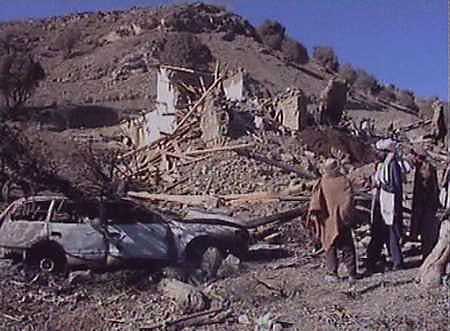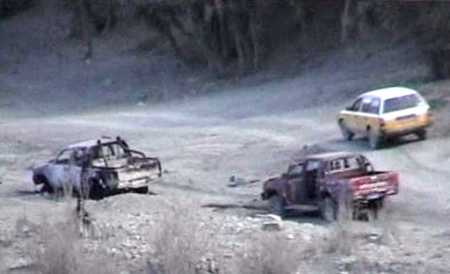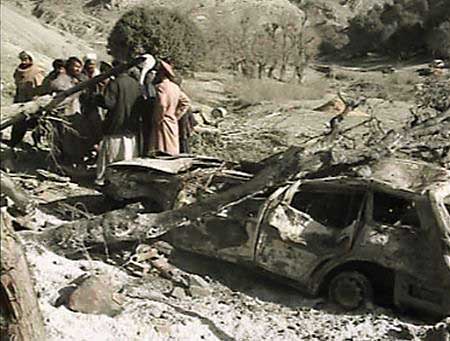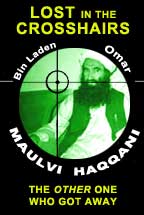
Residents in the village of Asmani Kilai, in the southern Paktia province of Afghanistan, look through the rubble of their houses December 22, 2002 after U.S. air strikes. Villagers told Reuters Television that 15 cars, 10 homes and a mosque were destroyed when U.S. warplanes attacked a convoy of vehicles carrying tribal elders to the installation of a new government in Kabul. The United States has said it believes the cars were carrying members of Osama bin Laden's al Qaeda network. (Reuters Tv/Reuters)
An Average Day
65 Afghan Civilians Killed by U.S. Bombs on December 20th
"...we believe it was a good target."
-- U.S. General Tommy Franks
By Marc Herold
POSTED DECEMBER 29, 2001--
Between October 7 - December 6, U.S. aerial attacks on Afghanistan had killed an average of 62 innocent civilians a day. The bombing of a convoy of tribal elders during the night of December 20th is right on the trend line.
On Friday, December 21st, the Pakistani daily Jang newspapers cited an Afghan news agency [certainly the Afghan Islamic Press agency] that at least 15 civilians had been killed as U.S. planes had assaulted a village in eastern Afghanistan with bombs [Jang. newsp. 18:40 PST, Dec. 21st].1 The two eastern provinces of Nangarhar and Paktia have been heavily bombed since late November.
At 17:10 GMT, BBC News broke the "convoy" story, noting U.S. Defense Secretary Donald Rumsfeld had admitted that U.S. planes had bombed a large convoy carrying either Taliban or Al Qaeda members, though other reports including from a member of the Paktia government told the BBC that 15 people had been killed.
Early the next morning, the Paknews.com Web site reported that 15 civilians had been killed Friday during an American bombardment of the Sato Kandaw area, 25 kms [15 miles] south of Gardez, the capital of Paktia province, adding that some of the killed included former mujahedeen commanders. The Washington Times picked up the story late on Friday, citing conflicting casualty reports - 65 by the Afghan Islamic Press and 15 by the Independent. It mentioned reports from Afghanistan noting names of elders from Khost who had perished in the attack. The Washington Times also noted the U.S. air strikes in the Sarkando area of Paktia in which at least 20 people had been killed and dozens injured.
By 1 p.m. on Saturday, Mohammed Bashir had filed a detailed report for the Reuters news agency, "Locals Reject U.S account of Afghan Convoy Attack." Bashir quoted residents of the village, Asmani Kilai, in the Ozi district of the eastern Paktia province, who told of attacks beginning Thursday night [9:00 p.m.] and lasting into Friday [4:00 a.m.], killing 50-60 people and destroying 15 vehicles.

This picture, taken from a television shot, shows pickup trucks (in lower part of photo) destroyed by U.S. air strikes near the village of Asmani Kilai, in the southern Paktia province of Afghanistan, December 22, 2001... (Reuters TV/Reuters)
He elaborated: "About 10 houses and a mosque [in Asmani Kilai] were also destroyed and several villagers not with the convoy were also killed." U.S. warplanes had actually attacked a convoy of vehicles carrying tribal elders to the installation of the new Karzai Government in Kabul. The convoy had left Khost and was approaching Gardez. The village of Asmani Kilai sits on barren hills and its houses were reduced to rubble.
By 5 p.m., the BBC News Online was running a story on the attack and the growing Afghan 'convoy row.' The BBC was citing tribal leaders in Gardez who said "65 people, including a number of tribal elders, had been killed in the attack - an allegation first reported on Friday by the Pakistan-based Afghan Islamic Press." The Times of London had picked up the story on Saturday, adding that the attacks had been carried out by U.S. Navy jets and AC-130 gunships, and that the attack was upon 14 vehicles in a convoy near Sato Kandaw, 15 miles south of Gardez.
In other words, the initial report of the independent Afghan Islamic Press, based in Islamabad, was accurate! A photo from Reuters TV of the carnage in Asmani Kilai is reproduced above. Subsequent reports have used the figures of 65 dead and 40 people injured.
The immediate response of the Pentagon was that the convoy had been attacked because it was a convoy of Al Qaeda leaders or members of the ousted Taliban. General 'Tommy' Franks visiting Kabul, commented on Saturday, "I will tell you, having been in touch with my headquarters, that at this point we believe it was a good target." He added, "we believe it was a bad convoy. We have reason to believe it was a good target." Pentagon spokesperson, Lt. Colonel David Lapan said there was no doubt, the U.S had hit the bad guys. A little later, the Pentagon added a further 'spin' to the story: the convoy had been attacked because a U.S. aircraft had been fired upon by anti-aircraft missiles from the convoy. Interviewed villagers dismissed that account, saying the convoy had set out for Kabul via Gardez from Khost with unarmed tribal elders.
The Reuters report elaborated upon the carnage:
"Six wrecked cars, their bodywork riddled with bullets and shrapnel, stood on the track. Shrapnel and the remains of spent ordnance littered the dirt. The villagers said more vehicles had been hit further along the route in air strikes they said occurred between 9:00 p.m. on Thursday and 4:00 a.m. on Friday 'Why is this tyranny happening to us?' asked Haji Khyal Khan, a villager who said five members of his family had been killed. Locals picked through the rubble of their homes retrieving what possessions they could, including a tattered carpet."
Another villager, Agha Mohammed, said , "There were no terrorists. They destroyed a whole village and we've lost everything."

By Sunday, December 23rd, further details had emerged, reported in the Pakistan Observer and the Times of India. The convoy caravan was led by anti-Taliban tribal chief Moulvi Mian Jan and comprised 'hundreds of people' belonging to the Niyazain tribe from Khost. A tribal jirga of the Niyazain met on Saturday, declaring that the incident had been caused by 'Afghan agents working for the U.S and having satellite telephones' who misguided the U.S military into attacking the convoy. The Guardian [December 27, 2001] clarified that the jets first struck the convoy killing 15, and then returned hitting nearby villages raising the death toll to 65.
The Times of India by Sunday was quoting survivors of the attack. One such survivor, Haji Yaqub Khan Tanaiwal, described the event---presumably an attack by the lethal AC-130 gunship---from his bed in a hospital in Peshawar [Pakistan]:
"I saw several cars on fire. We were about six people in our car and every one of us was hit...those who survived in the first raid ran for cover under trees or besides rocks. Others were trapped inside their cars...every vehicle was hit in the first raid. {addressing the U.S report that its warplanes had come under fire from the convoy, Tanaiwal continued} this is a cover. I never heard a single shot fired from the convoy...all in the convoy were supporters of the new administration."
Another wounded man, Mazali, said seven members of his family were killed in the bombing. Among the dead in Asmani Kilai was the leader of the Pashtun Ahmadzai tribe, Naeem Kochi. Mohammed Ibrahim, brother of Afghan commander [and Taliban official] Mauli Jalaluddin Haqqani, was also killed. 2
By Sunday, December 23rd, Gulab Din, head of the Zadran tribe in Paktia, was threatening to launch war attacks against the new Karzai regime if U.S jets launched another attack on his area.
This recent incident follows a pattern well-established over the past 10 weeks of U.S. bombing: First come the initial reports of civilian casualties from regional news agencies, then, denials by the Pentagon, and finally further details about the specifics of the attack, which get ignored by the U.S. military, political elite and domestic mainstream media, though are widely reported in the foreign press.
-- 30 --
Footnotes
1 This account is prepared from the following sources: "15 Killed in U.S Bombing Raid on Afghan Village," The International News [jang] [December 21, 2001]; "Confusion Over U.S Bombing Raid," BBC News Online [December 21, 2001]; "U.S Bombing Targets Convoy," The Washington Times [December 21, 2001]; Mohammed Bashir [Reuters], "Locals Reject U.S Account of Afghan Convoy Attack,": Daily News.yahoo.com [December 22, 2001]; Stephen Farrell, "'Friendly Fire' Fear as Convoy is Bombed," Times [December 22, 2001]; "U.S Bombing Kills 80 Civilians," NewsMax.com Wires [December 22, 2001]; "Afghan Convoy Row Grows," BBC News Online [December 22, 2001]; "65 Killed as US Planes Bomb Afghan Convoy," Dawn [December 22, 2001]; "U.S Commander Insists Afghan Convoy was Legitimate Target," Pakistan Observer [December 23, 2001]; "Villagers Dispute US Claim on Convoy," Times of India [December 23, 2001]; ""Survivor Recounts US Bombing of Afghan Convoy," Times of India [December 23, 2001]; and ""Tribal Leader Warns Karzai of War Over US Raids," Times of India [December 23, 2001].
2 Jalaluddin Haqqani served as Taliban tribal affairs minister. He had been a prominent leader in the 1980sstruggleagainst the Soviets. Haqqani is a northern Pashtun with his power base in Khost, Paktia and Paktika. Haqqani has long-standing ties with Pakistan's intelligence services. The center of Taliban power was in Kandahar, home of the southern Pashtuns.
